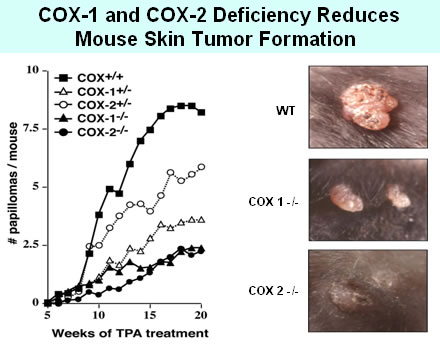 |
|
Physiological Roles for COX-1 & COX-2 Robert Langenbach, Ph.D.
Principal Investigator Tel (919) 541-7558 Fax (919) 541-1460 langenb1@niehs.nih.gov P.O. Box 12233 Mail Drop C4-09 Research Triangle Park, North Carolina 27709 Delivery Instructions Research SummaryThe cyclooxygenases, COX-1 and COX-2, are the target enzymes for a class of drugs known as nonsteroidal antiinflammatory drugs (NSAIDs). While both isoforms have important roles in the maintenance of normal physiology and also contribute to the development of various pathological conditions; little is known about the individual functions of the two isoforms.  Figure 1. Effects of COX deficiency on skin tumor numbers and morphology.
A major goal of Metabolism & Molecular Mechanisms Group has been to use COX-1 or COX-2 deficient mice to identify the individual physiological and pathophysiological roles of the two COX isoforms. A long standing interest of the laboratory has been to elucidate the mechanisms by which COX-1 and COX-2 contribute to tumor development (Figure 1) and concomitantly determine if both isoforms are suitable targets for chemoprevention. Additionally, the group has investigated the fetal and postnatal developmental roles of each COX-1 and COX-2. The above studies, as well as new studies investigating the roles of prostaglandin receptors in tumor development, constitute the major areas of research in the laboratory. Major areas of research:
Current projects:
Robert Langenbach, Ph.D., leads the Metabolism & Molecular Mechanisms Group within the Laboratory of Molecular Carcinogenesis. He earned his Ph.D. in 1966 at The University of Nebraska. He has published 134 peer-reviewed articles in leading biomedical journals as well as several book chapters. He served as an Associate Professor at The University of Nebraska Medical Center before joining NIEHS in 1983. |
|

